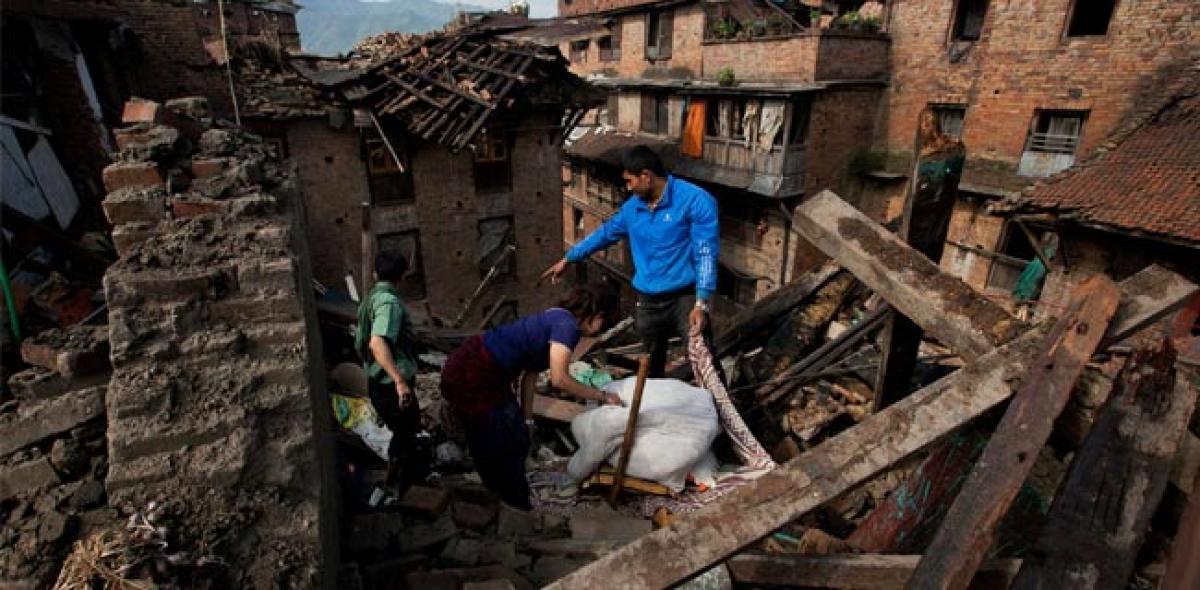Live
- Chanchalguda Jail Officials Say They Haven't Received Bail Papers Yet, Allu Arjun May Stay in Jail Tonight
- BJP leaders present evidence of illegal voters in Delhi, urge EC for swift action
- Exams will not be cancelled: BPSC chairman
- Nagesh Trophy: Karnataka, T.N win in Group A; Bihar, Rajasthan triumph in Group B
- YS Jagan condemns the arrest of Allu Arjun
- Economic and digital corridors to maritime connectivity, India and Italy building vision for future, says Italian Ambassador
- SMAT 2024: Patidar's heroics guide Madhya Pradesh to final after 13 years
- CCPA issues notices to 17 entities for violating direct selling rules
- Mamata expresses satisfaction over speedy conviction in minor girl rape-murder case
- Transparent Survey Process for Indiramma Housing Scheme Directed by District Collector
Just In

Extensive groundwater extraction in the Indo-Gangetic Plain over the last five decades has \"significantly\" contributed to the killer April 25, 2015, Nepal temblor and \"probably all earthquakes\" in the region beneath the Himalayan arc, Indian scientists claim.
Kolkata: Extensive groundwater extraction in the Indo-Gangetic Plain over the last five decades has "significantly" contributed to the killer April 25, 2015, Nepal temblor and "probably all earthquakes" in the region beneath the Himalayan arc, Indian scientists claim.
Researchers at NIT Rourkela; CSIR-National Geophysical Research Institute, Hyderabad; and National Centre for Seismology (NCS), ministry of earth sciences, New Delhi, have gathered evidence of the far-reaching consequences of human actions: how groundwater depletion can "advance the clock" of temblors occurring in the Main Himalayan Thrust (MHT), under the Himalayan arc where earthquakes originate.
"Plate tectonics is the prime driving force behind earthquakes but in the past decade there is a new trend of research.
"The focus is also on surface and sub-surface activities such as underground mining, fluid injection and reservoir construction due to hydropower projects as possible contributing factors to seismic activity," Bhaskar Kundu of the Department of Earth and Atmospheric Sciences, NIT Rourkela, told IANS.
Earlier it was considered that small magnitude earthquakes are influenced by the seasonal loading and unloading (removal process of groundwater) of the Indo-Gangetic Plain in summer and winter, said NCS director Vineet Gahalaut, one of the authors of the study.
"We have shown that great and major Himalayan earthquakes are influenced by the anthropogenic groundwater unloading process in the Indo-Gangetic Plain, which is probably the most intensely irrigated region in Southeast Asia," Gahalaut said.
Comprising about 250 million hectares of fertile land (most of northern and eastern part of India) the Indo-Gangetic Plain is the most populated region of India, Pakistan, and Bangladesh.
It is also home to 40 percent of India's population. Population density is highest in eastern Uttar Pradesh and Bihar in India and northern Bangladesh, leading to very high irrigation activities.
Kundu and his colleagues carried out a novel stress modulation study in the area, through hydrological and satellite-based observation of ground water depletion by human activity.
"Around seven percent of this process (anthropogenic ground water depletion) has contributed to advancement of the clock, that is, the timing of the earthquakes. The saturation level for stress is attained early due to depletion of groundwater. This is quite significant," Kundu pointed out.
In 2014, geophysicists in the US reported the depletion of groundwater in the San Joaquin Valley, modulating stress levels on the San Andreas Fault and thereby heightening the risk for earthquakes.
"It is interesting to note that groundwater unloading (removal) rate is about six times more in the Ganga basin in comparison to that in the San Joaquin Valley," N.K. Vissa, one of the authors, pointed out.
The recent study published in Geophysical Research Letters implies that the "Nepal earthquake and probably all earthquakes occurring on the MHT beneath the Himalayan arc are influenced by the anthropogenic modulation process related to groundwater extraction in the Indo-Gangetic Plain".
But veteran scientist B.K. Rastogi, former director general of the Gandhinagar-based Institute of Seismological Research (ISR) maintained such effects are accountable for minor stress change.
"Such effects, if any, may at the most cause minor stress change. The normal tectonic stress is too large," Rastogi said.
Geophysicist C.P. Rajendran said although the work is a "fresh approach", he found the model validation "problematic".
"The groundwater depletion in the Indo-Gangetic Plain goes back more than 40 years. We do not find any change in rate of seismicity in the Himalayas during this period. In other words, the frequency of large earthquakes originating from the Himalaya should have gone up if the model is right. We don't see that. Thus, their model lacks this fundamental validation," Rajendran of the Jawaharlal Nehru Centre for Advanced Scientific Research in Bengaluru, told IANS via email.

© 2024 Hyderabad Media House Limited/The Hans India. All rights reserved. Powered by hocalwire.com







